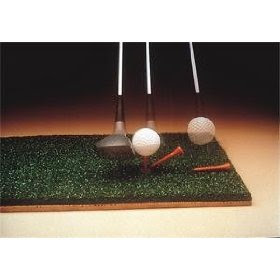 Foolish mortal, I ignored the gods and took my trusty 9-iron out into the teeth of the gale. My plastic balls too light to stand still on the hitting mat, with my Callaway Soft-Flite balls and my Almost Golf" balls, I hit my two buckets in the course of the afternoon. That was all I could manage. I knew that if I tried for more, I could definitely count myself among the certifiably insane. When it comes right down to it, I don't know why that thought even occurred to me. The idea of hitting outside today at all was completely insane. Even in extreme circumstances, like these, there is humor, if you can ignore the sore throbbing of your nearly frozen fingers long enough to think about it. At the end of my second bucket, as I was wandering around the backyard with the shag bag in one hand, I thought that if I fell down for some reason and couldn't get up, I would be frozen solid by the time anybody found me, a solid statue to the mindlessness of my preoccupation. Thankfully, the outside ordeal was worth it.
Foolish mortal, I ignored the gods and took my trusty 9-iron out into the teeth of the gale. My plastic balls too light to stand still on the hitting mat, with my Callaway Soft-Flite balls and my Almost Golf" balls, I hit my two buckets in the course of the afternoon. That was all I could manage. I knew that if I tried for more, I could definitely count myself among the certifiably insane. When it comes right down to it, I don't know why that thought even occurred to me. The idea of hitting outside today at all was completely insane. Even in extreme circumstances, like these, there is humor, if you can ignore the sore throbbing of your nearly frozen fingers long enough to think about it. At the end of my second bucket, as I was wandering around the backyard with the shag bag in one hand, I thought that if I fell down for some reason and couldn't get up, I would be frozen solid by the time anybody found me, a solid statue to the mindlessness of my preoccupation. Thankfully, the outside ordeal was worth it.
The reason that I was willing to confront the elements for a few swings was that, since my practice two days ago, I had a new realization, and I wanted to try out my swing to see if I could do what I imagined I should do. And that thing was a full swing. A completely relaxed swing around a full arc, just like Bobby Jones. No muscular control that would prevent me from a complete follow-through.
You're saying to yourself something like, "Well, what do you think you've been trying to do these three years?" But that's where I now know more than you do. This thing—this golf swing—is so subtle and recondite and elusive that we amateurs can hardly reach the end of our exploration of it. As my wife often says to me after a practice, "That's what you always say! 'I've got it!'" She's right, and by now, I know that all I have, after the last practice, is the latest revelation and that there are many more revelations to come.
This one happens to be about the weight of the club and being able to swing it around an arc without interposing oneself. In other words, I'm starting to feel the sensations associated with actually swinging the club, instead of controlling it. Now, if you've been reading my posts, you'll know that this idea has been growing on me. Even lately, with all the help of the left-arm alone drill, I tend to think about the swing as ending at the ball. If you look at my videos, including the one below, you'll see how I characteristically take a slow motion practice swing that ends at the ball, not one inch farther.
So my idea, which came to me, I think, yesterday, when it snowed all day, courtesy of Boreas, was that I needed to loosen up even more and let the swing go all the way to the follow-through. By now, I think my left arm knows about the release. What I needed to teach it was to continue right on through without interruption or hindrance. As Mark, my first teaching pro, said, you swing "and the ball is in the way." Such a simple thought, but how difficult to do.
So today, I concentrated on being loose and relaxed. I wanted to feel the club hinge at the top of the swing. I wanted to feel the clubhead lag behind the swing. I wanted to feel the club go flying through the release and continue into the follow-through and finish up over my shoulders, the way the pros do. And I wanted to be able to still hit the ball where I wanted to! That's a big condition. As you know, if you change the slightest thing in your swing, that change has major ramifications, all of them bad.
In my layers of warm clothing and my too-thin gloves, I worked on feeling loose. On keeping my left arm as straight as I could. On keeping my right knee flexed. On keeping the lag deep into the swing. On letting the club go and feeling a complete follow-through. As you'll see in the video, I succeeded to an extent. I made progress. And that's what we want from a practice session. Especially at sixteen degrees.








